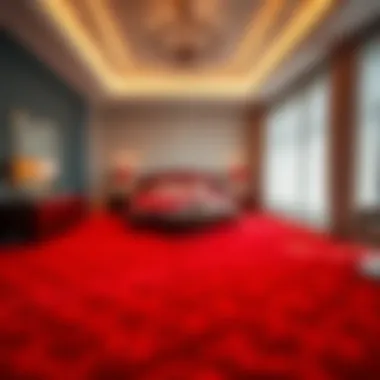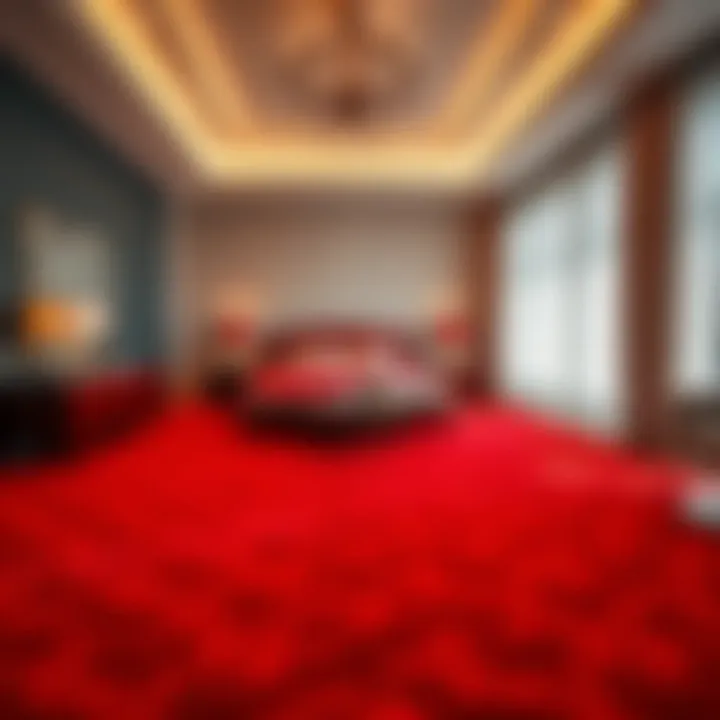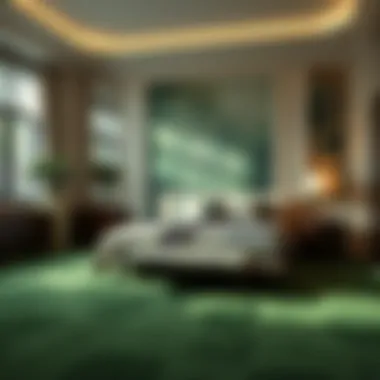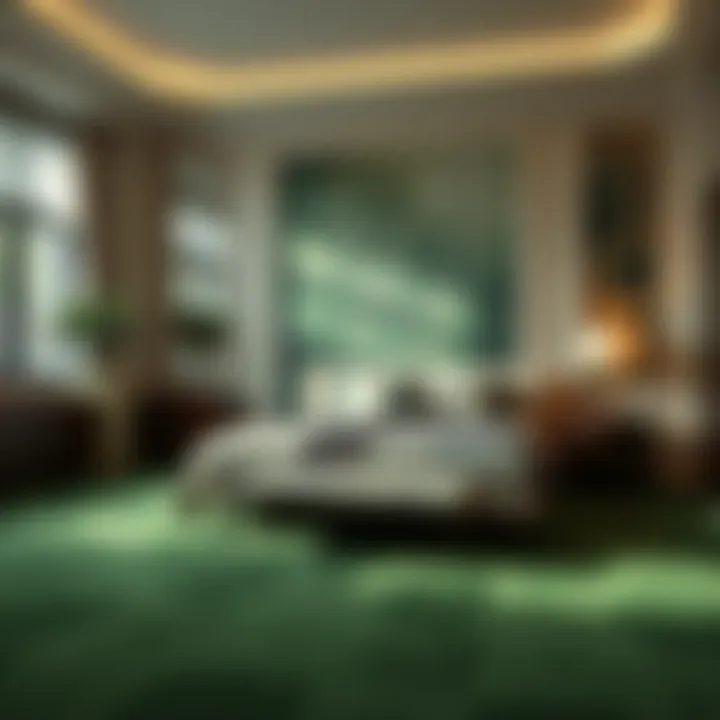Choosing the Perfect Carpet Colors for Your Bedroom


Intro
Choosing the right carpet color for your bedroom is more than just a matter of aesthetics. It's an articulate blend of design vision, personal preference, and emotional resonance. The colors you select can create atmospheres that soothe the soul or invigorate the spirit. As homeowners and housewives navigate the plethora of options available, understanding current trends while considering timeless elements can enhance the overall impact of the space.
In this article, we will explore the various dimensions of carpet color selection for bedrooms. We will cover trending styles that resonate with today's design preferences and delve into color palettes that align with the desired mood you aim to create. From the calming neutral hues that provide tranquility to the bold accents that add personality, the choices you make can truly transform your sanctuary into a special retreat.
As we journey through this exploration, we focus on how color can influence both the aesthetic appeal and emotional well-being, bringing life and flavor to your bedroom design.
The Role of Color in Interior Design
When it comes to creating a harmonious living environment, color undoubtedly plays a leading role. In bedrooms, where personal expression and comfort are paramount, color choices extend beyond mere aesthetics. They can influence the mood, affect the perception of space, and even evoke emotional responses. Understanding the pivotal role color plays in interior design is essential for anyone looking to revamp their sleeping quarters.
Color sets the tone for any space. For bedrooms, shades of blue might evoke a sense of calmness, while warmer colors like reds and yellows can energize the ambiance. This understanding of color's impact allows homeowners to craft a sanctuary tailored to their needs. When selecting carpet colors, the choice becomes integral to the overall design.
Understanding Color Theory
Delving into color theory provides the framework for making informed decisions. At its core, color theory encompasses the relationships between colors, their meanings, and how they interact. The color wheel, a fundamental tool in this exploration, categorizes colors into primary, secondary, and tertiary. This visual guide helps to harmonize and balance your choices.
Here are a few key elements:
- Complementary Colors: Colors opposite each other on the wheel create contrast and can energize a space.
- Analogous Colors: Those next to each other tend to create a serene and cohesive look.
- Monochromatic Schemes: Utilizing different shades of a single hue can provide a sophisticated vibe without overwhelming the senses.
Thus, when selecting a carpet color, understanding these principles can refine your choices and guide your overall design philosophy.
Psychology of Color in Bedrooms
The psychological effects of color are profound. Each hue carries specific connotations, and this can alter how a space feels and how people within it behave. For instance, studies suggest that blue tones can lower heart rates and create an atmosphere conducive to relaxation, making them ideal for bedrooms.
Conversely, striking shades like bright reds or vibrant oranges can stimulate energy and increase alertness. For someone who enjoys reading in bed or working on personal projects, a pop of these colors might pleasantly disrupt the calmness of softer shades.
When making choices about carpet color, consider these aspects:
- Warm Tones: Inviting and energetic; can make a space feel cozy but might be too stimulating for a bedroom.
- Cool Colors: Transmit calmness; ideal for creating that retreat feel, and they often complement natural light beautifully.
- Neutral Colors: Provide a classic base and versatility; they can anchor bold decor choices without overwhelming.
"Color is the keyboard, the eyes are the harmonies, the soul is the piano with many strings." – Wassily Kandinsky
Trends in Bedroom Carpet Colors
When it comes to bedroom design, trends in carpet colors can make or break the ambiance of the space. As homeowners and decorators seek to create environments that reflect personal styles and emotional needs, understanding these trends becomes essential. The choice of carpet color can affect how light is perceived in a room, influence mood, and even dictate the way furniture and accessories are selected. Keeping up with current trends helps to ensure your space feels modern, inviting, and harmonious.
Contemporary Color Palettes


In today’s world, contemporary color palettes often lean towards a mixture of both bold and soft hues, reflecting a trend that speaks to versatility and individualism. Shades like deep navy or forest green create depth and richness, while softer hues like dusty rose or light sage offer a calming presence. These color choices aren't just aesthetically pleasing but also functional, enabling homeowners to tailor their environments according to personal preferences.
- Earthy Tones: Colors such as terracotta, muted browns, and warm taupes resonate with nature, providing a grounding effect.
- Vibrant Accents: Pairing neutral carpets with pops of color through pillows and wall art ensures a contemporary touch without overwhelming the senses.
- Monochrome Schemes: An all-white or all-gray carpet can serve as a clean canvas, perfect for showcasing eclectic furniture and accessories.
The versatility of these contemporary palettes allows for easy adjustments as trends evolve. For instance, changing just a few decorative elements can shift the room's vibe without the need to replace a carpet.
Timeless Shades That Endure
Despite the ever-changing landscape of interior design, certain carpet colors remain timeless, transcending passing trends and trends. Neutrals, for instance, offer an elegant backdrop for ongoing style evolutions. Shades like beige, cream, and gray can adapt to various decor styles, from classic to modern and everything in between.
Additionally, darker colors like charcoal or deep brown offer a level of sophistication and resilience, effectively hiding dirt and stains, making them perfect for busy households.
“Timeless colors provide lasting beauty and functionality.”
Classic colors do more than just endure; they serve as a foundation on which homeowners can build their unique interpretations of style. In combining these enduring shades with current decor elements, individuals can effortlessly achieve a charming balance of traditional and modern aesthetics.
Incorporating both contemporary palettes and timeless shades provides a dynamic range of choices for carpet color selection that contributes to the overall harmony and functionality of bedroom spaces. This nuanced understanding enhances the approach to bedroom design, allowing for a cohesive style that will remain visually appealing for years.
Choosing the Right Carpet Color
Selecting the appropriate carpet color for your bedroom is no small feat. It’s a decision that shapes the overall feel and atmosphere of the space. Carpets not only add warmth and comfort but they also serve as a canvas upon which the rest of the room is painted. A well-chosen carpet color can accentuate the mood you want to create, whether it be calming, invigorating, or something in between. Moreover, considering specific elements like size, light, and existing decor helps ensure that your choice remains in harmony with the overall aesthetic of your sanctuary.
Making this selection involves balancing personal preference with practical considerations. A light color may open up a smaller room, while darker shades can be cozy and intimate. Further, knowing the place's primary function—whether it's a master suite, guest room, or children's space—will guide you towards colors that complement your lifestyle. This section will unpack key factors like bedroom size, natural light, and the existing decor, all crucial in helping you land on the perfect hue.
Consider the Bedroom Size
When you're knee-deep in the decision-making process about carpet colors, the size of the bedroom stands as a principal factor. For smaller bedrooms, lighter shades can create an illusion of spaciousness, almost like a breath of fresh air in tight quarters. Think of soft beiges, pale grays, or even muted pastels—these colors reflect light beautifully, making the room feel airy and open.
Conversely, larger bedrooms can afford bolder choices. Darker shades or rich jewel tones can help to create a more intimate, grounded atmosphere. Imagine a navy blue or deep forest green in a roomy master suite—it can make the area feel cozy rather than cavernous. Still, it’s vital to balance this with furniture and wall colors to avoid an overwhelming effect.
"The size of your bedroom can be a game-changer in your carpet color choice. Leverage light tones in compact spaces; go bold in expansive areas."
Assessing Natural Light
Natural light is another heavyweight in the decision ring. It can dramatically alter how a color appears at different times of the day. In rooms flooded with sunlight, a bright white or a vibrant shade might feel too harsh. Such colors can be tempered into something more subdued, offering a warmer feel.
On the flip side, if your bedroom lacks windows or receives little sunlight, opting for darker or muted tones can help the room appear dreary. Instead, consider warming colors like sandy taupe or cheerful yellows that can still emit a sense of brightness despite the limited light. To thoroughly assess how to adapt your carpet choice, grab a few samples and see how they interact with natural daylight at various times to make an informed decision.
Coordinating with Existing Decor
Last but not least, consider what’s already in your bedroom—all those beautiful pieces of furniture and decor you’ve lovingly chosen should blend well with your new carpet. Your carpet needs to complement or contrast—whichever speaks to you—without drowning out the defined style.
For a contemporary room, try selecting a carpet that incorporates elements from your decor, like a color found in your bedspread or curtains. On the other hand, if your bedroom is dressed in vintage tones, rich reds or soft greens can enhance that nostalgic vibe. Avoid choosing a carpet color that’s too far removed from your decor palette; it can disrupt the flow of the design.


Popular Carpet Colors for Various Styles
Choosing the right carpet color is a significant part of bedroom design. It not only adds aesthetic value but also shapes the overall mood of a room. To achieve a harmonious balance between style and comfort, understanding popular carpet colors and their roles in various style categories is essential. These choices can convey elegance, vibrancy, or a serene atmosphere, depending on the selected hue. Each color has its unique characteristics that resonate with different decor styles, which elevates the bedroom experience for homeowners.
Neutral Tones for Classic Elegance
Neutral tones, such as beige, grey, and taupe, are often the unsung heroes of interior design. They serve as a perfect backdrop that allows other elements of the room to shine. The beauty of neutral-colored carpets is their versatility. They can easily coexist with vibrant furniture or artwork without clashing. For instance, a soft beige carpet might complement bold-patterned bedding or colorful wall accessories beautifully.
Moreover, neutral tones promote a sense of calmness and balance, which can be especially valuable in a bedroom setting. When selecting a neutral carpet, consider the undertones. Warm beiges might be apt for a room with warm-toned woods, while cooler greys align better with modern, minimalist decor. This selection reinforces the lived-in feel of a space, adhering to a more classic elegance while allowing one to play with textures and shapes.
Bold Hues for a Dynamic Space
If you want to inject energy into your bedroom, bold hues like deep navy, vibrant red, or rich emerald can do just that. These colors command attention and can transform an otherwise mundane space into a lively atmosphere. Think of a deep navy carpet that grounds a room filled with lighter furnishings. The contrast not only adds depth but creates a striking focus that invites conversation.
Opting for bold colors can often reflect the personality of the homeowner. However, caution is advised—balance is key. Introducing bold colors works best when paired with complementary elements. For instance, a striking red carpet may be toned down with lighter walls or subtle accents. This approach avoids overwhelming the senses and instead cultivates a dynamic yet cohesive setting.
Pastels for a Soft Ambiance
If your goal is to create a sanctuary filled with softness and tranquility, pastel colors like soft pink, light blue, or muted lavender come into play. These gentle shades evoke feelings of relaxation and serenity, perfect for unwinding after a long day. A pastel carpet can pull together a soft palette of linens and decor, making the bedroom feel airy and inviting.
Incorporating pastels can work wonders in smaller spaces too, as lighter colors tend to give an illusion of openness. Pairing a soft lavender carpet with light wood furniture and crisp white linens fosters an invigorating freshness. But don't just stop at walls or linens; consider layering textures, such as chunky knits or plush throws, to amplify the comforting vibe that pastels bring.
"Color is the keyboard; the eye is the harmonium; the soul is the piano with many strings." – Wassily Kandinsky
Choosing the right carpet colors involves balancing practicality with aesthetic appeal. Beyond looks, consider how these tones reflect your style and influence the mood of your personal space. With the wide array of options available, the right hue can bring your bedroom to life.
Material Considerations for Carpets
When it comes to selecting carpets for a bedroom, the choice of material is as important as the color. While hue can dramatically affect the mood, the fibers chosen shape a carpet's durability, appearance, and feel underfoot. Let's delve deeper into various aspects associated with material considerations for carpets, highlighting their specific elements, benefits, and important factors that decision-makers should keep in mind while planning their bedroom style.
Synthetic vs. Natural Fibers
The debate between synthetic and natural fibers continues to be a significant point to ponder.
- Synthetic fibers, such as nylon and polyester, are often praised for their durability and stain resistance. They're like the reliable workhorse in the world of carpets. Nylon is renowned for its resilience, making it ideal for households with kids or pets. On the flip side, polyester offers vibrant colors and patterns, adding a splash of pizzazz to the bedroom.
- Natural fibers, including wool and cotton, take us back to basics—providing a luxurious feel and breathability. Wool, for instance, is not only soft but also absorbs moisture, making it a superior choice in terms of temperature regulation. However, they sometimes require a bit more care and aren't as stain-resistant as their synthetic counterparts.
Choosing between these fibers boils down to lifestyle and care capacity. For those seeking low maintenance and vibrant options, synthetic might be your best bet. If you're after a more organic feel and are willing to juggle some extra care, natural fibers could be well worth the investment.
Texture's Impact on Color Perception
Texture plays an underappreciated yet crucial role in how we perceive color in a carpet. Different textures can create various visual effects and even alter the mood of a room.
- Shag carpets, for example, translate colors into a cozy, inviting ambiance. The plush nature tends to soften the saturation of colors, giving it a warmer feel.
- On the other hand, flatweave carpets can produce a more vibrant color effect because of their stable surface. This might play into enhancing the brightness of blues or greens effectively.


Moreover, textures contribute dramatically to the overall room style. A luxurious, velvety carpet may instantly elevate sophistication, while a slimmer textured pattern can suit a more casual aesthetic.
"The right texture doesn’t just complement the color; it enriches it like a fine wine enhances the meal."
Overall, when considering bedroom carpets, it’s essential to think beyond color alone. Understanding materials, from fiber types to textures, equips homeowners with the knowledge to create a balanced environment in terms of feel, style, and practicality. As this component plays a significant role in the overall design, it underscores how intricately woven choices affect the space.
For more insights on carpet materials, you may want to check out resources from Wikipedia and Britannica.
Understanding these elements fosters informed choices that mirror not just aesthetic preference but practicality in day-to-day life.
Maintenance and Care for Bedroom Carpets
Keeping your bedroom carpets in top shape isn’t just a chore; it’s essential for enhancing their lifespan and ensuring your space remains inviting. Just like a well-tended garden blooms brighter, a well-maintained carpet has a certain life and vibrancy that can elevate the entire room. Overlooking the proper care can lead to costly replacements and unwanted odors that could dampen even the coziest atmosphere.
One major factor to consider is how different activities in the bedroom can impact carpet durability. For instance, if you have kids or pets, your carpets are likely to endure more wear and tear compared to a quieter space. Regular maintenance can mitigate these issues, keeping your carpet looking fresh and welcoming.
Regular Cleaning Practices
The heart of carpet maintenance lies in consistent cleaning. Here’s a simple guideline to keep your bedroom carpets looking sharp:
- Vacuum regularly: Aim for at least once a week. Frequent vacuuming helps remove dirt and dust that can gradually wear down your carpet fibers. Don't forget those nooks and crannies, where dust likes to play hide-and-seek!
- Shampoo and deep clean periodically: Depending on the foot traffic and usage, consider shampooing your carpets every six months to a year. Inexpensive steam cleaners can often do wonders, or you might want to hire a professional service for deep cleaning.
- Implement preventative measures: Placing mats at the entrances can catch dirt before it spreads through your carpets. Additionally, consider using chair pads under heavy furniture to avoid indentations.
- Be mindful of humidity and ventilation: Good airflow can help in drying up spills faster, reducing the chances of mold growth. A dehumidifier can come in handy during humid seasons.
"An ounce of prevention is worth a pound of cure." This old saying rings especially true when it comes to keeping your carpets fresh.
Addressing Stains and Damage
Stains and damages can feel like a dark cloud hanging over an otherwise lovely carpet. However, with quick action and some clever techniques, you can manage these unforeseen mishaps effectively:
- Act fast: When spillages occur, blot the stain immediately with a clean cloth. Rubbing can further damage the fibers and make the stain worse.
- Know your cleaning solutions: Simple mixtures like vinegar and water can often combat common stains effectively. For more stubborn spots, there are myriad commercial stain removers specifically formulated for different types of stains. Always test a small area first!
- Repair small holes or frays: If you notice loose threads, you can often cut them without further damage. For larger issues, consider patching if it’s a significant tear.
- Professional help for persistent problems: If certain stains refuse to budge or the damage is more than you can handle, it might be prudent to consult a carpet cleaning professional. They possess the know-how and equipment to handle myriad carpet issues, leaving your space tidy once again.
Taking time for maintenance and care not only keeps your bedroom inviting but also reflects a certain pride in the space you’ve created. By establishing regular practices and tackling problems promptly, you can enjoy your carpet in its best form for many years to come.
End
In any interior space, colors play a pivotal role, especially when it comes to bedroom carpets. Selecting the right carpet color can dramatically reshape the atmosphere and emotional landscape of your bedroom. Beyond aesthetics, it’s about creating a sanctuary that reflects personal style while fostering comfort and tranquility.
Carpet color influences how we feel upon entering the room. For instance, calm blues or soft greens can evoke serenity, making them an ideal choice for those seeking relaxation. On the flip side, brighter shades like vibrant oranges or yellows might be better suited for creative spaces or energizing environments.
Key considerations in choosing a carpet color include:
- Personal Preference: Everyone's tastes differ. Your choice should resonate with your personality and preferences.
- Bedroom Purpose: A guest room may benefit from neutral carpets that cater to varied styles, while a personal space might embrace colors that reflect your individuality.
- Lighting Variations: How natural and artificial light interacts with carpet color can alter the perceived hue throughout the day. Think about how the light shifts in your space when selecting shades.
- Coordination with Existing Decor: The color of the carpet must harmonize with other elements in the room. From wall hues to bed linens, consistency breeds a polished look.
In essence, the conclusion of this journey through carpet color ideas highlights its multi-layered significance. Selecting an appropriate carpet color involves a thoughtful approach, considering how it intertwines with your personal environment and emotional well-being. A well-chosen carpet can turn an average bedroom into a customized retreat.
Final Thoughts on Bedroom Carpet Colors
Choosing the right carpet color is not merely about picking a shade off a swatch. It's about crafting a space that feels right for you. Remember: no choice is wrong, but some may be more aligned with your desires and the mood you wish to cultivate. Whether leaning towards classic neutrals for that timeless look or bold hues for a statement, each choice offers a myriad of possibilities to shape your haven.
Ultimately, making an informed decision about bedroom carpet colors requires you to blend practical insights with a personal touch. This ensures your space doesn’t just look good but feels right too.















